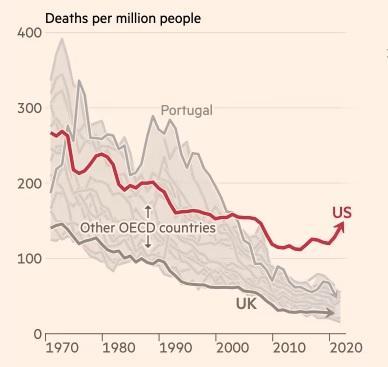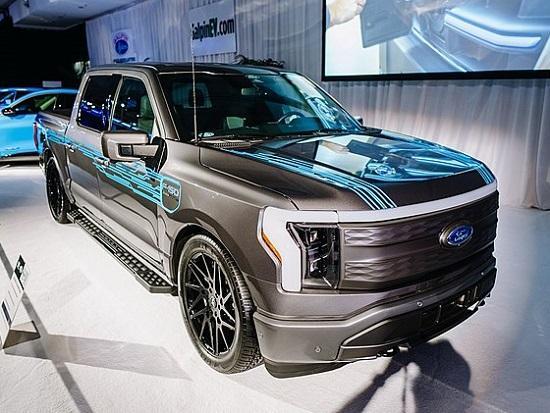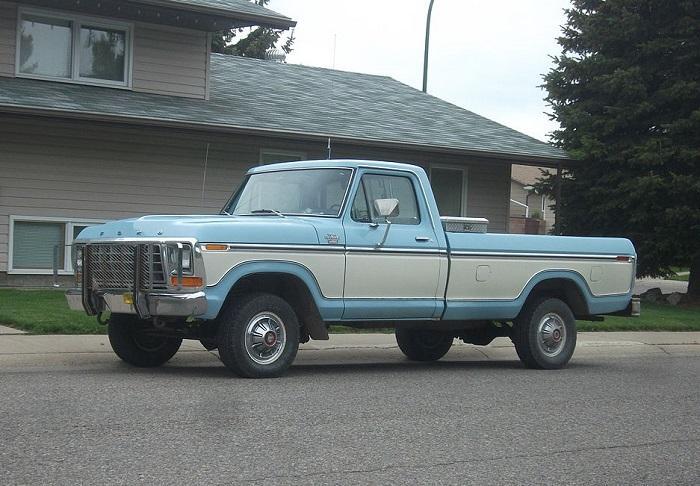Why America Has A Higher Road Death Rate Than Other Developed Countries
You know what I find interesting? It’s how much we love our cars. We take pride in them, we name them, and some of us even see them as an extension of ourselves. I’ll never forget the best car I ever owned: an old, beat-up Ford pickup truck. I did everything with that thing, used it for fun, used it for work, and appreciated it more than any other car I ever owned. But what’s depressing is that this love for our cars also has a dark side. I was drinking my morning coffee today, and I stumbled upon a news article in the Financial Times about the high rate of U.S. road deaths compared to other countries, and it’s clear that our car culture is playing a role in this. The Financial Times article was a little annoying because it took a bit of a swipe at American Car Culture (I like my cars, thank you very much), but I found the facts contained within the article to be fascinating, and I decided to write about it. So, in this article, we’ll explore why America has a higher road death rate than other developed countries, and what we can do to address this issue.
Big Cars and Trucks
For visitors to the US, the sheer size of the cars, the relative lack of electric models, and speed limits that seem entirely optional can be overwhelming. Road fatalities were the second leading cause of death among Americans aged under 45 in 2021, ahead of Covid-19, suicides, and gun violence. In comparison to other developed countries, the US has the highest mortality rate due to road deaths.
Why?
The average new American car purchased in 2021 weighed 1.94 tonnes, half a tonne more than the European average. Purchases of SUVs and “light” trucks together account for four out of every five new vehicles bought in the US, up from one in five 50 years ago. Interestingly, this trend in car purchasing maps to the US political divide as well, with Republicans more likely than Democrats to buy a new vehicle of any kind and vastly more likely to buy a big one.
However, as American cars have bulked up, the number of fatalities for the drivers and passengers inside these rolling fortresses has fallen by 22 percent. But the number of pedestrians killed has risen by 57 percent. According to an estimate, the lives of 8,000 pedestrians could have been saved between 2000 and 2018 if Americans had stuck to smaller vehicles.

The Physics of Large Vehicles
The laws of physics dictate that a larger, heavier vehicle will provide better crash protection than a smaller, lighter one. This is because the front end of a vehicle is designed to crumple and absorb the energy from crashes. The longer front ends of larger vehicles offer better protection in frontal crashes, and heavier vehicles tend to continue moving forward in crashes with lighter vehicles and other obstacles, so the people inside them are subject to less force.
In recent years, automakers have made design changes to align the energy-absorbing structures of newer SUVs and pickups with those of cars. This means that the threat that SUVs and pickups pose to people in small vehicles has been reduced.
However, a lighter vehicle will always be at a disadvantage in a collision with a heavier vehicle. An analysis of crashes in 2000-01 involving 1997-99 model vehicles showed that SUVs and pickups were much more likely than cars or minivans of the same weight to be involved in crashes that killed occupants of other cars or minivans.
And for pedestrians, the situation is even more bleak. According to a recent study by the Insurance Institute for Highway Safety (IIHS), SUVs and pickup trucks are much more likely to hit and kill pedestrians when turning than cars. The study, which analyzed thousands of police reports of single-vehicle, single-pedestrian accidents at or near intersections, found that pedestrians were more frequently killed by vehicles making turns than those traveling straight. Left turns were more dangerous than right turns, and pickups were found to be the deadliest, followed by vans, minivans, and SUVs. Cars were the least likely to cause pedestrian fatalities.
Although more research is needed to understand the role of visibility in these accidents, the IIHS suggests that a likely explanation for the findings is simple physics: drivers are more likely to hit an obstacle they can’t see. The thick A-pillars of larger vehicles may limit drivers’ visibility in turns, which could explain why thicker pillars were associated with more fatalities in the study.
Pedestrian crash deaths have been on the rise in recent years, reaching a peak in 2020 with 6,500 pedestrian fatalities and 54,700 injuries. While driver assists such as automatic emergency braking can help avoid some accidents, the IIHS stresses the importance of drivers paying attention and being able to see the road.
Reckless Driving Habits
Many drivers and passengers in the front seat of US cars do not wear a seatbelt, and 45 percent say they often drive at least 15 miles per hour above the speed limit on motorways. In contrast, in the UK, both measures are way lower, at 3 percent. The grim result is that half of the car occupants killed in the US in 2020 were not wearing seatbelts compared to 23 percent in the UK. Speeding is implicated in 30 percent of fatal crashes in the US but just half of that in Britain.
In 2021, almost 43,000 people died in traffic crashes in the United States—the most since 2005. This increase is partially attributable to Americans driving more miles than they did in 2020, when many stayed home because of the COVID-19 pandemic. More than 7,300 pedestrians were killed in 2021, the highest number in at least 30 years. The rising death toll comes after dozens of US cities committed to the “vision zero” goal of eliminating roadway deaths.
US law does not require seatbelt use in the back seat, unlike the overwhelming majority of the world. The U.S.’s seat-belt-wearing rate has improved to 90 percent, but peer nations are doing better. In Canada, the seat belt wearing rate is 95 percent. Our drunk driving laws are also too lenient compared to peer nations and compared to WHO recommendations.
The U.S. also lags world leaders in vehicle safety, falling short of the standards established by the United Nations. For example, the US in recent years has resisted adding safety features to vehicles that would help protect pedestrians in crashes, even as their fatality rates soar.
The Environmental Impact
Less than 5 percent of new US cars last year were either partly or fully electric, compared with 17 percent in Europe. As a result, the average new US car emits twice as much carbon dioxide per mile as its European counterpart, all while carrying the same number of occupants as in the UK — 1.5 people per trip, weighted for distance driven.
How to Make Things Better?
Solving environmental and public health challenges requires considering the needs of others. The US has made strides in recent years to address some of the issues that contribute to higher road death rates, but much more needs to be done.
Here are some potential solutions that could help:
- Implement stricter speed limits: One of the key factors in the high road death rate in the US is excessive speed. By enforcing stricter speed limits, particularly in residential areas and school zones, the number of fatalities and injuries caused by speeding could be significantly reduced.
- Encourage the use of public transportation: The US is a car-centric society, with many people viewing car ownership as a symbol of freedom and individualism. However, this mindset has contributed to the high number of cars on the road, which in turn leads to more accidents. By encouraging the use of public transportation, carpooling, or other alternatives to driving alone, the number of cars on the road could be reduced.
- Improve infrastructure for pedestrians and cyclists: As Article 2 highlighted, pedestrians and cyclists are particularly vulnerable on US roads. By creating safer walking and biking routes, such as separated bike lanes and pedestrianized city centers, cities can make it easier and safer for people to walk and bike instead of driving.
- Encourage the use of smaller, more fuel-efficient cars: The US has a long-standing love affair with big, powerful cars. However, as Article 1 noted, these cars have a variety of lethal qualities, including higher carbon emissions and a greater risk of fatalities in accidents. By encouraging the use of smaller, more fuel-efficient cars, the environmental impact of driving could be reduced while also making roads safer for everyone.
- Increase enforcement of traffic laws: One reason why the US has a higher road death rate than other developed countries is the relatively lax enforcement of traffic laws. By increasing enforcement of traffic laws, particularly around speeding and seatbelt use, the number of fatalities and injuries caused by reckless driving could be reduced.
- Improve driver education and training: Many US drivers receive very little training or education beyond the basics of operating a vehicle. By improving driver education and training, drivers could be better equipped to handle challenging road conditions and avoid accidents.
- Implement technology to improve safety: as just one example, the Insurance Institute for Highway Safety found that pickup trucks equipped with Automatic Emergency Braking (AEB) technology have a 43% lower rate of rear-end crashes. As this technology has proven to reduce the crash rate, automakers should accelerate the pace of equipping pickup trucks with AEB technology to improve safety on the road

The Ford F-150 Lightning is a fully-electric full-size light duty truck that was unveiled by Ford in May 2021. It has four models, and all are dual-motor, four-wheel-drive, with EPA range estimates of 230–300 mi (370–480 km). The truck is expected to help Ford sell two million EVs a year by 2026. The vehicle is available in the US with prices ranging from $39,974 for the commercial-grade version all-wheel drive (AWD) truck to $90,000 for higher-power/trim/range models. The base version of the truck has 452 hp (337 kW), 230 mi (370 km) range, and a smaller battery that supports a 2,000 lb (910 kg) payload.
Conclusion
Ultimately, solving the problem of the US’s high road death rate will require a shift in attitudes towards driving. By putting a little more emphasis on safety, the US can make its roads safer for everyone.
References:
- https://www.ft.com/content/a75a6623-67f4-41d1-a0ca-cedc9fda4f90
- https://commons.wikimedia.org/wiki/File:Ford_F-150_truck_(7306393350).jpg
- https://usa.streetsblog.org/2018/12/13/why-the-u-s-trails-the-developed-world-on-traffic-deaths/
- https://www.urban.org/urban-wire/us-traffic-fatalities-rising-what-would-it-take-save-lives
- https://www.iihs.org/topics/vehicle-size-and-weight
- Article from cars.com about automatic emergency braking
- Ford Lightning Image










